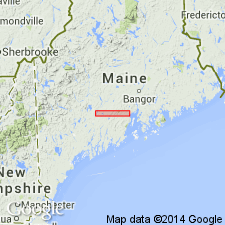
- Usage in publication:
-
- Vassalboro sandstone
- Modifications:
-
- Named
- Dominant lithology:
-
- Sandstone
- Quartzite
- AAPG geologic province:
-
- New England province
Summary:
Named Vassalboro sandstone for the town of Vassalboro, Kennebec Co., south-central ME. The Vassalboro is typically a massive, bluish-gray sandstone. Locally it is recrystallized and becomes a quartzite. Where shale layers are associated with the quartzite the shales have become altered to biotite schist, while in places where the pressure has been less intense phyllite layers have formed. Correlation of the Vassalboro with the Waterville formation indicates that the Vassalboro is of Middle Silurian age.
Source: GNU records (USGS DDS-6; Reston GNULEX).
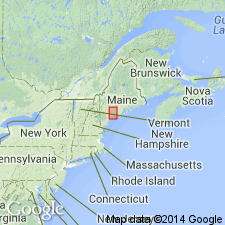
- Usage in publication:
-
- Vassalboro formation
- Modifications:
-
- Revised
- AAPG geologic province:
-
- New England province
Summary:
The Vassalboro formation is typically a massive, bluish-gray sandstone. Locally it is quartzite; shaly layers have been altered to pyritiferous mica schists. Contains numerous calcareous beds. Increase in the intensity of metamorphism of the Vassalboro formation produced the lime-silicate gneiss of the Androscoggin formation. The Androscoggin of the Tacoma Lakes area was identified by Perkins and Smith (1925) as the Vassalboro. Due to its varying lithologies, the Vassalboro is revised to the Vassalboro formation.
Source: GNU records (USGS DDS-6; Reston GNULEX).
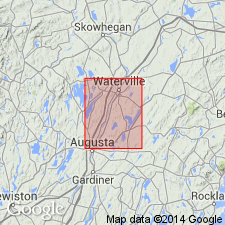
- Usage in publication:
-
- Vassalboro Formation
- Modifications:
-
- Overview
- AAPG geologic province:
-
- New England province
Summary:
The Vassalboro was assigned a Silurian age based on its correlation with the Waterville formation in which graptolites were found. However, the Vassalboro is interpreted to be older than the Waterville. The Vassalboro consists of a monotonous sequence of heavy bedded wacke with minor phyllitic interbeds. A thin black phyllite at the contact with the Waterville is discontinuous along strike. The rocks of the Vassalboro have recrystallized in response to low-pressure intermediate metamorphism. Due to its stratigraphic position below the Waterville, the Vassalboro is assigned a Wenlock or younger age.
Source: GNU records (USGS DDS-6; Reston GNULEX).
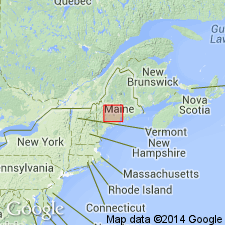
- Usage in publication:
-
- Vassalboro Formation
- Modifications:
-
- Biostratigraphic dating
- AAPG geologic province:
-
- New England province
Summary:
Carbonaceous metapelite within the lower part of the Vassalboro Formation was sampled for graptolites. The poor preservation of the fossils limits their usefulness; a Silurian age is suggested.
Source: GNU records (USGS DDS-6; Reston GNULEX).
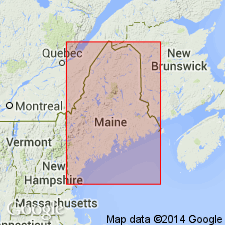
- Usage in publication:
-
- Vassalboro Formation*
- Modifications:
-
- Overview
- AAPG geologic province:
-
- New England province
Summary:
The Vassalboro has a large outcrop area even though attitudes of bedding are mostly vertical; estimating the thickness of the unit is difficult, but is presumably less than 3,200 meters thick. Considering the thickness of the Vassalboro, the age of the overlying unit, and the graptolites collected by Pankiwskyj and others (1976), the age of the Vassalboro is probably Llandoverian (Early Silurian) although the lower part of the formation could be as old as latest Late Ordovician.
Source: GNU records (USGS DDS-6; Reston GNULEX).
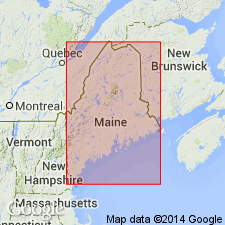
- Usage in publication:
-
- Vassalboro Formation
- Modifications:
-
- Not used
- AAPG geologic province:
-
- New England province
Summary:
Suggests abandoning the Vassalboro Formation. Recent observations suggest that the Vassalboro includes rocks that can be correlated with the Sangerville and Waterville Formations as well as rocks older than the Waterville. Suggests using the name Hutchins Corner Formation instead.
Source: GNU records (USGS DDS-6; Reston GNULEX).
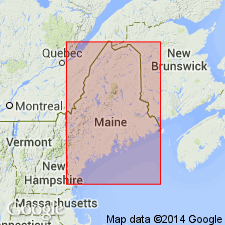
- Usage in publication:
-
- Vassalboro Formation
- Modifications:
-
- Age modified
- Areal extent
- AAPG geologic province:
-
- New England province
Summary:
Term Vassalboro Formation is used here for unit in Windham-Gorham area, southern ME, which was originally designated Berwick Formation (Katz, 1917; Hussey, 1968; 1971). Berwick in southeastern NH now considered to be late Precambrian (Bothner et al, 1984), while Vassalboro is Late Ordovician and Early Silurian. Underlies Windham Formation (Early Silurian). Intruded by Sebago batholith (Carboniferous).
Source: GNU records (USGS DDS-6; Reston GNULEX).
For more information, please contact Nancy Stamm, Geologic Names Committee Secretary.
Asterisk (*) indicates published by U.S. Geological Survey authors.
"No current usage" (†) implies that a name has been abandoned or has fallen into disuse. Former usage and, if known, replacement name given in parentheses ( ).
Slash (/) indicates name conflicts with nomenclatural guidelines (CSN, 1933; ACSN, 1961, 1970; NACSN, 1983, 2005, 2021). May be explained within brackets ([ ]).

